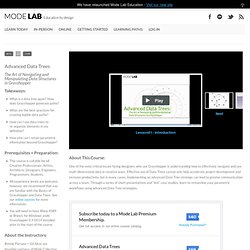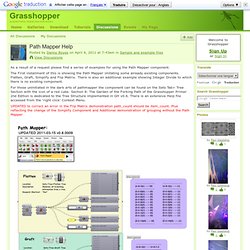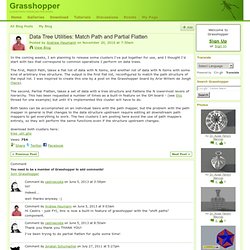

Data matching. Generative Design Computing: Data Trees. Advanced Data Trees. The Art of Navigating and Manipulating Data Structures in Grasshopper Takeaways: What is a data tree again?

How does Grasshopper generate paths? What are the best-practices for creating legible data paths? How can I use data trees to re-organize elements in my definition? Prerequisites + Preparation: This course is suitable for all Creative Professionals: Artists, Architects, Designers, Engineers, Programmers, Students.All experience levels are welcome; however, we recommend that you are familiar with the Basics of Grasshopper and Data Trees. About the Instructors: Ronnie Parsons + Gil Akos are founding partners of Mode Collective. About This Course: One of the most critical issues facing designers who use Grasshopper is understanding how to effectively navigate and use multi-dimensional data in creative ways. Get full access to our entire course catalog. Enroll in this course to gain full access to the video series and instructor files.
Grasshopper Lecture 4: Data Trees, Structure. Data Trees (2/2) - Data Trees. Data Trees (1/2) - Data Trees. Advanced Data Trees. Grasshopper Lecture 4: Data Trees, Structure. Grasshopper lectures. Path Mapper Help. As a result of a request please find a series of examples for using the Path Mapper component.

The First installment of this is showing the Path Mapper imitating some already existing components. Flatten, Graft, Simplify and Flip Matrix. There is also an additional example showing Integer Divide to which there is no existing component. For those uninitiated in the dark arts of pathmapper the component can be found on the Sets Tab> Tree Section with the icon of a red cube. Section 8: The Garden of the Forking Path of the Grasshopper Primer 2nd Edition is dedicated to the Tree Structure implemented in GH v0.6. UPDATED to correct an error in the Flip Matrix demonstration path_count should be item_count. Updated: 2011-04-20 Replace Branches Not sure if it's right to include this here as its actually encouraging you not to use the Path Mapper, but sometimes there are benefits to being able to keep the definition free from restrictions like the Path Mapper.
Attachments: ▶ Reply to This. Data Matching - Data Trees. Blog Binturong: Grasshopper Tutorials Part 2.2. Data Tree Utilities: Match Path and Partial Flatten. In the coming weeks, I am planning to release some clusters I've put together for use, and I thought I'd start with two that correspond to common operations I perform on data trees.

The first, Match Path, takes a flat list of data with N items, and another list of data with N items with some kind of arbitrary tree structure. The output is the first flat list, reconfigured to match the path structure of the input list. I was inspired to create this one by a post on the Grasshopper board by Arie-Willem de Jongh (here). The second, Partial Flatten, takes a set of data with a tree structure and flattens the N lowermost levels of hierarchy. This has been requested a number of times as a built-in feature on the GH board - (see this thread for one example) but until it's implemented this cluster will have to do. download both clusters here:
Data Trees (1/2) - Data Trees. Data Trees (2/2) - Data Trees. Trees.